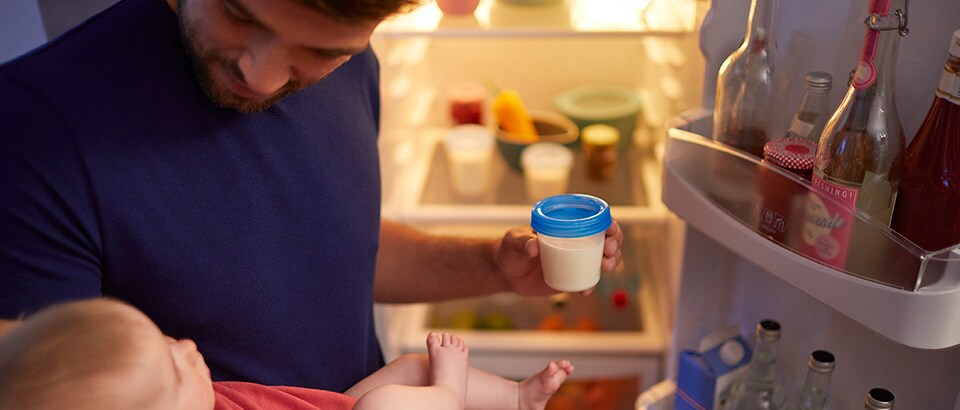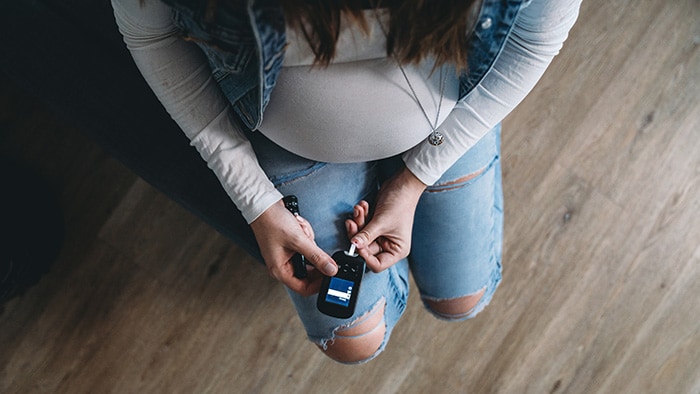November 2021
A fresh look at stored breast milk

Once pumped, breast milk must be stored safely – for proper hygiene and to preserve its unique nutrients. Let’s review the basics and the research.
Mother's milk, fed to baby straight from the breast, is the optimum way for newborns and babies to receive all the nutrition nature intended. However, for a number of practical reasons, pumping and storing breast milk is an everyday reality for many moms.
Luckily, breast milk that has been stored properly is the second best option for babies. Teaching parents and caregivers the best ways to store precious breast milk is not only a key means of avoiding bacterial contamination - it's also important to preserving the milk's nutrients. Let's review the basics - and take a look at what researchers are saying.
Preparing for storage
Infants are vulnerable to infections, so storing breast milk safely begins with cleanliness - from the moment the milk is being expressed. Before pumping, hands need to be thoroughly washed. The pump must also be clean - and the containers (and lids) used for storage need to be sterilized.
Parent also should pay careful attention to the type of container used. They must be of food-grade quality glass or (non-BPA) hard plastic - with lids that can be securely closed. For the sake of convenience, parents can opt for pre-sterilized breast milk storage bags, which are disposed of after use.
Cleanliness also applies to the fridge and freezer. Any food spilled should be wiped up right away. Regular cleaning is also important. Throw out old food to avoid cross-contamination - and wipe surfaces with a disinfectant to reduce the growth of Listeria and other bacteria.
Storing smaller quantities of milk is preferable - and if freezing, leave some empty space at the top of the container to allow room for the milk to expand.
Proper labelling
To keep track of which milk to use first, parents should label each container using a pen with waterproof ink to note the date the milk was pumped. If the milk is going to be used at a daycare facility, it's also good to note the baby's name so there won't be any mix-ups.
Fridge and freezer
Once pumped, breast milk will stay good for up to 4 hours at room temperature - though to preserve nutrients, it's best to put it in cool storage right away. In the fridge, the milk can be stored up to 5 days at 4°C or lower. It's better not to keep the containers on the door shelfs. Each time the door is opened, the milk is exposed to shifts in temperature - and to light, which can cause water soluble vitamins to oxidize.
In the freezer, breast milk can be stored at -18°C or colder for up to 6 (and even 12) months, but longer storage may affect the quality of the milk.
If needed, breast milk can also be kept in a cooler using ice packs, but for no longer than 1 day. Freshly pumped breast milk can be added to milk that's already been refrigerated or frozen - but it's important that the new milk is cooled before adding, to keep the chilled milk from warming up.
The right temperature
It's good to remind parents how to maintain those ideal temperatures. Don't open the door too long. Make sure the rubber sealing around the doors is clean, and not broken or out of place. And before putting any cooked food in the fridge, let it cool down first on the countertop to avoid raising the temperature inside.
Because many households maintain too high a temperature in their refrigerators and freezers, it's also smart to check the control panels to confirm the actual temperature. If the isn't a control panel - or for more accuracy - use a separate refrigerator/freezer thermometer.
Manufacturers recommend placing the thermometer in a glass of water in the fridge overnight - then checking the temperature in the morning, the first time the fridge is opened.
For freezers, tuck the thermometer between frozen foods and leave it overnight. Then make any adjustments to the settings, to achieve the ideal range of temperatures. To keep an eye on the temperature, leave the thermometer inside the fridge and freezer, so parents and caregivers make sure everything's ok from week to week.
Maintaining milk's nutrients
Storing milk affects its nutrients. Most breastfeeding moms will alternate between feeding straight from the breast and using pumped milk that's been stored for a short period of time. In this case, there's no real need to worry about the nutrient loss. This differs for babies that are exclusively fed stored breast milk - such as preterm infants fed stored donor milk.
According to research1, the vitamin C in stored mother's milk quickly deteriorates. Breast milk stored in the fridge for just 24 hours (or frozen for 1 month) showed around a 30% decrease in total vitamin C. After 2 months in the freezer, vitamin C had decreased by two-thirds.
This led the researchers to recommend limiting the storage of mother's milk (used in neonatal units) to 24 hours in a fridge, and 1 months in a freezer - and if the milk must be stored longer, it's worth considering giving the baby vitamin C supplements. Another study2 found that after 7 day in the freezer, breast milk's macronutrients - fats, proteins and lactose - as well as the energy content of the milk had decreased. Though, as mentioned above, if the stored milk is used in combination with feeding straight from the breast, this should not be a concern.
Preparing for use
It's no surprise that babies tend to prefer drink stored breast milk at or near body temperature. Too hot isn't good either. Unlike formula, "human milk is a live fluid"3, and heating it above 80°C can cause beneficial properties to disappear. The North America Human Milk Banking Association (HMBANA) recommends warming no higher than 40°C (lukewarm and close to body temperature).
Frozen milk should be defrosted overnight in the fridge. A quicker way to thaw is to use the baby bottle warmer. Or parents can place the frozen milk in lukewarm water - in this case, it's important to check the temperature before using it for feeding. And because freezing ruptures the fat globule membrane, thawed breast milk will have cream floating to the top. It is important that this is gently stirred back into the milk to keep the remaining fat from adhering to the bottle.
Once thawed, mother's milk can be kept in the fridge for up to 24 hours, or for 1-2 hours at room temperature. It should never be refrozen after thawing. And if baby didn't manage to finish her bottle, it's ok to save the rest for later - as long as she receives her additional feeding within 2 hours.
The microwave dilemma
For parents (and daycare workers) in a hurry, microwaving can seem like a great solution, but in general, this is not recommended. Often, microwaves cannot be set accurately, and they heat milk unevenly. This can cause hot spots that can burn baby's mouth. And too much heating can lead to a loss of nutrients and fat content.
On the other hand, researchers have found "that microwave heating of human milk can be performed without significant losses of examined immunoglobulins and nutrients, provided that final temperatures are below 60°C."4
So if no other options are available, very careful microwaving can be possible. Place the milk in a microwave-safe container (without a lid), and set the microwave to its lowest power level. Heat for a few seconds - a small amount of milk heats quickly! - shake to distribute the heat, and test the temperature. If needed, zap it again for a few seconds, shake, and test the temperature again.
Share this article:
Related Articles
Not a Healthcare Professional?
References
1. Buss IH, McGill F, Darlow BA, Winterbourn CC. Vitamin C is reduced in human milk after storage. Act a Pædiatr 2001; 90: 813–15. Stockholm. ISSN 0803-5253
2. García-Lara NR, Escuder-Vieco D, García-Algar O, De la Cruz J, Lora D, Pallás-Alonso C. Effect of freezing time on macronutrients and energy content of breastmilk. Breastfeed Med. 2012;7(4):295-301. doi:10.1089/bfm.2011.0079
3. Bransburg-Zabary, Sharron et al. “Human Milk Warming Temperatures Using a Simulation of Currently Available Storage and Warming Methods.” PloS one vol. 10,6 e0128806. 10 Jun. 2015, doi:10.1371/journal.pone.0128806
4. L. Ovesen, J. Jakobsen, T. Leth & J. Reinholdt (1996) The Effect of Microwave Heating on Vitamins B1 and E, and Linoleic and Linolenic Acids, and Immunoglobulins in Human Milk, International Journal of Food Sciences and Nutrition, 47:5, 427-436, DOI: 10.3109/09637489609006956



